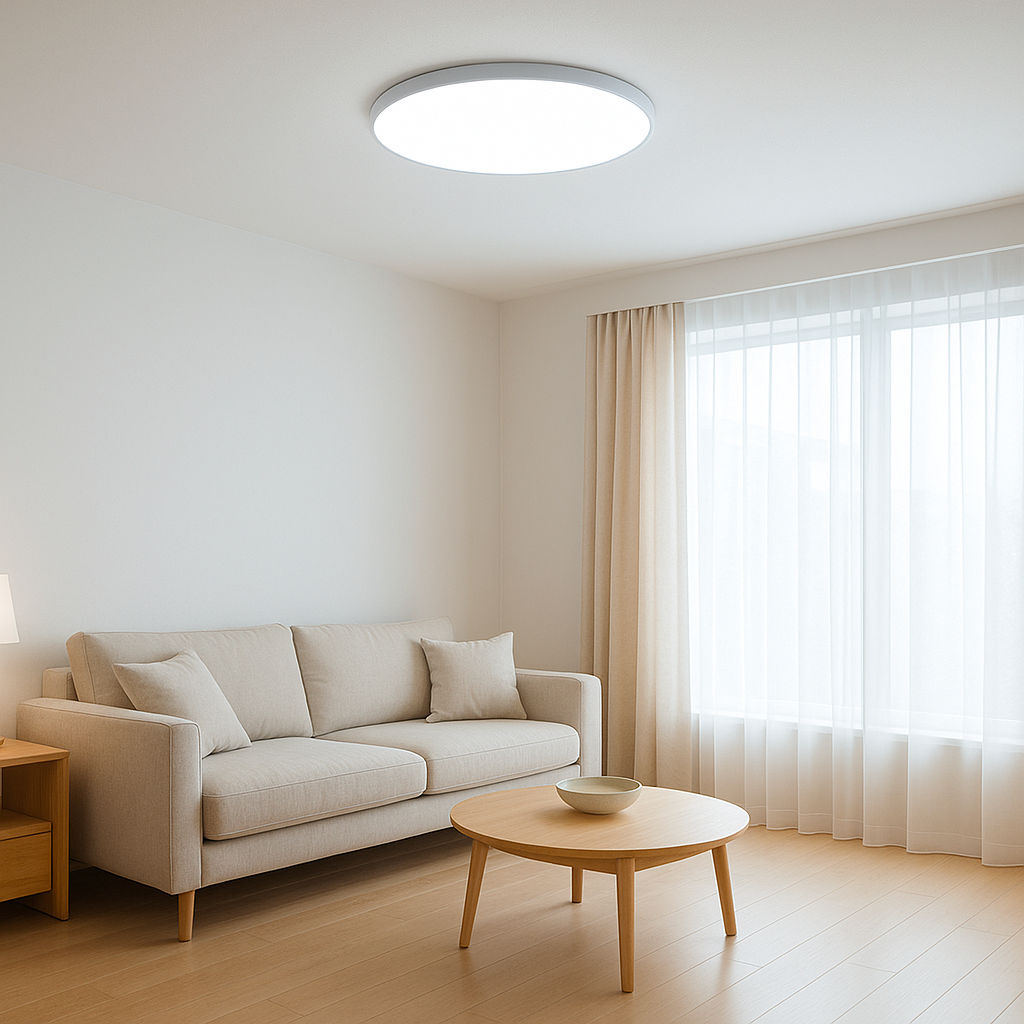Ceiling lights are almost everywhere in modern home lighting, often taking center stage in living rooms, bedrooms, kitchens, and even hallways. As a lighting product that “stays close to daily life,” the evolution of ceiling lights also reflects changes in lighting technology and aesthetic preferences. From initially providing basic illumination to now combining design and smart features, the evolution of LED ceiling lights has been both practical and fascinating.
Design Evolution: From Bulky to Ultra-Thin Minimalism
Early ceiling lights were often bulky, with thick lampshades that could create a sense of heaviness when installed on the ceiling. As LED light sources became smaller and heat dissipation technology improved, ceiling lights gradually evolved into slim, ultra-thin designs. Clean lines and lightweight construction allow these fixtures to blend seamlessly with various interior styles, especially in spaces with lower ceilings, making them both functional and visually enhancing.
At the same time, advances in materials and manufacturing have made the fixtures lighter, more durable, and more translucent, balancing aesthetics with daily comfort and safety. Today, many models feature frameless designs or slightly curved edges, turning ceiling lights into not just lighting tools but also decorative elements in the space.
Function Upgrade: From Single Color to Smart Control
The evolution of functionality is one of the most noticeable aspects of LED ceiling lights. Initially, fixtures offered only fixed single-color light sources. Later, adjustable color temperature became common, allowing users to switch freely between warm and cool white light according to different scenarios.
With the rise of smart technology, ceiling lights now support dimming, color adjustments, and even RGB lighting effects, all controllable via smartphone apps or voice assistants such as Alexa and Google Assistant. Lighting is no longer a simple “on/off” function—it has become a flexible, customizable experience. Some high-end models even integrate with other smart home devices, enabling lights to sync with music or create automated scenes with curtains, air conditioning, and more, fully immersing lighting into the smart home ecosystem.
Application Expansion: Extending to Various Spaces
Initially, LED ceiling lights were mainly used for home lighting. However, with improvements in functionality and design, their applications have expanded significantly. In offices, neutral and high-power fixtures are preferred for bright, efficient illumination. Restaurants and shops focus on ambiance, using adjustable color temperature or accent lighting to create unique experiences. In educational and medical environments, high-CRI, flicker-free lights are ideal for eye comfort and professional requirements. These scenario-based applications make LED ceiling lights not just a lighting tool but also an essential component for enhancing space quality.
Technical Optimization: Enhancing the User Experience
Beyond design and functionality, technical details greatly influence the user experience:
-
Flicker-Free Drivers: High-quality drivers prevent invisible flickering, protecting eye health.
-
Color Rendering Index (CRI): High CRI ensures more natural and true-to-life colors, ideal for study areas or makeup spaces.
-
Heat Dissipation and Lifespan: Effective thermal structures maintain stable brightness and extend fixture life, with some LED ceiling lights lasting up to 50,000 hours.
-
Energy Efficiency and Eco-Friendliness: Compared to traditional lighting, LED ceiling lights consume less energy, aligning with modern sustainability standards.
-
Ease of Installation: Many modern fixtures feature modular designs for simple installation, allowing users to replace components themselves if needed.
Application Adaptation: Multi-Scenario Suitability
LED ceiling lights now extend beyond traditional home use. Small fixtures suit hallways, entryways, or bathrooms, medium-sized fixtures fit bedrooms and study rooms, and larger fixtures can illuminate living rooms, dining areas, or office spaces. Some models also include moisture-proof, insect-resistant, or memory-light functions, making them suitable for kitchens, bathrooms, and commercial spaces. This versatility enhances comfort and usability while meeting diverse lighting needs.
Smart Upgrade: From Control to Scene Experience
With the growth of IoT, AI, and smart home systems, LED ceiling lights are becoming increasingly intelligent. Beyond basic dimming and color adjustments, future ceiling lights are expected to offer more automation and environmental awareness:
-
Adaptive Lighting: Adjusts brightness and color temperature automatically based on room light, time of day, and user habits, balancing energy savings and comfort.
-
Healthy Lighting: Simulates natural light patterns and reduces blue light to improve sleep quality and regulate circadian rhythms.
-
Scene Integration: Works with curtains, air conditioning, and audio systems to create different lifestyle scenes, such as reading, entertaining, or movie-watching modes.
-
Remote Management: Allows users to control home lighting via smartphone apps or voice commands, enhancing convenience and security even when away.
These trends show that LED ceiling lights are no longer mere illumination tools—they are increasingly integrated into daily life and smart home ecosystems, enhancing both living quality and user experience.
LED Ceiling Light Forms and Applications
The evolution of ceiling lights is also reflected in the diversity of forms and applications:
-
7-inch 12W Round LED Ceiling Light: Compact and lightweight, suitable for hallways, entryways, or bathrooms.
-
12-inch 24W Round LED Ceiling Light: Moderate brightness, ideal for bedrooms or study rooms.
-
24-inch 45W Round LED Ceiling Light: High-power design, suitable for large spaces like living rooms or dining areas.
-
12-inch Smart RGBCW Ceiling Light (Alexa/Google Compatible): Combines color-changing and adjustable color temperature, controllable via app or voice, perfect for bedrooms, kids’ rooms, or entertainment areas.
Some models also include moisture-proof and insect-resistant features for kitchens and bathrooms, while high-end models offer light memory functions, restoring the previous brightness and color temperature each time they are turned on, catering to everyday habits.
Conclusion
The evolution of LED ceiling lights not only mirrors the development of lighting technology but also reflects changing lifestyles. From bulky to ultra-thin, from single color to intelligent control, these fixtures have gradually become more aesthetically pleasing, flexible, and user-friendly. In the future, LED ceiling lights are expected to integrate even more smart and design elements, combining IoT, healthy lighting, and sustainability concepts, making light an indispensable “invisible design” in both spaces and daily life.

